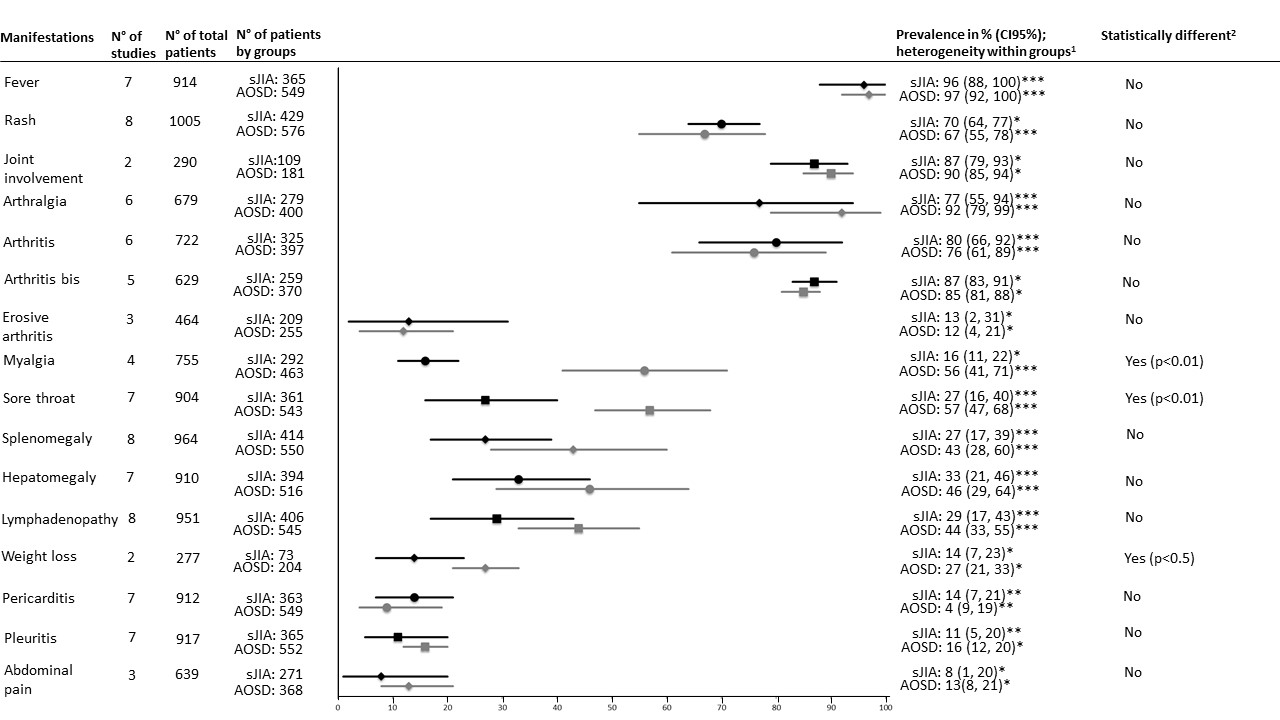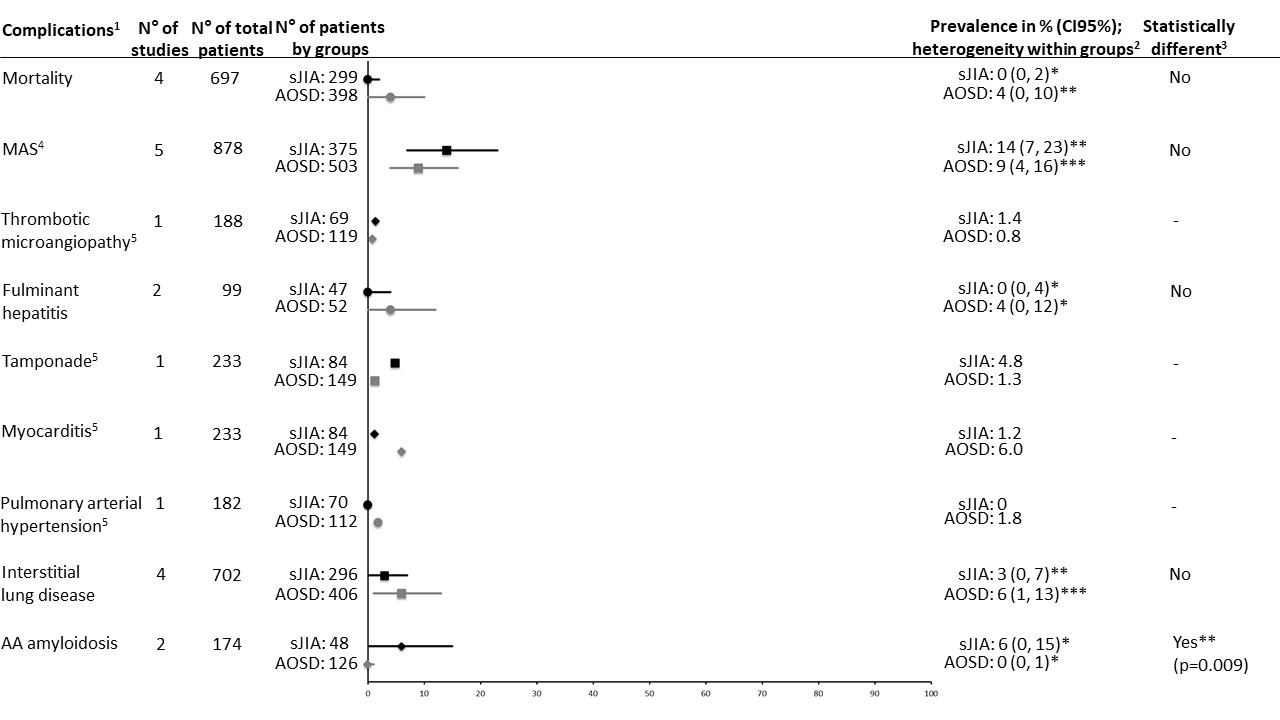Session Information
Session Type: Abstract Session
Session Time: 2:00PM-3:30PM
Background/Purpose: Systemic juvenile idiopathic arthritis (sJIA) and adult-onset Still’s disease (AOSD) are part of the non-familial (sporadic) systemic inflammatory disorders and are frequently mentioned as being the same disease occurring at different ages. However, they are studied disconnectedly leading to lost opportunities in therapeutic innovation and variability in clinical management. In this context, the European Alliance of Associations for Rheumatology (EULAR) and the Paediatric Rheumatology European Society (PReS) established a Task Force to issue the first recommendations for the diagnosis and management of sJIA and AOSD, acknowledging they are the same disease. The following work was undertaken to inform the Task Force. The objective was to analyze the prevalence of clinical manifestations (including complications) and laboratory findings in sJIA and AOSD.
Methods: Two systematic reviews (SRs) were performed. The first SR included cohort studies comparing sJIA vs AOSD with a description of clinical and biological manifestations (including complications) and with more than 20 patients per group (“prevalence SR”); the second SR identified studies in which biomarkers were tested in both diseases and their diagnostic performance evaluated (“diagnostic SR”). Medline (via PubMed), Embase, and Cochrane Library were systematically searched. The risk of bias was assessed with an adapted form of the Hoy scale for prevalence studies in prevalence SR and with the QUADAS in the diagnostic SR. We performed meta-analyses of proportions for the different qualitative descriptors using the Stata command metaprop.
Results: Eight studies were included in the prevalence SR (n= 1005 participants) and 33 in the diagnostic biomarker SR. There was no difference in the pooled estimated prevalence of clinical manifestations between sJIA and AOSD, except for myalgia, sore throat, and weight loss, which were more frequently reported in AOSD, as they are likely ascertained incompletely in sJIA, especially in young children (Figure 1). Except for AA amyloidosis, more frequent in sJIA, there was no statistical difference between sJIA and AOSD in terms of complication prevalence (Figure 2). Likewise, biological findings did not differ between groups (Figure 3). Ferritin, S100 proteins and interleukin-18 were the most frequently used diagnostic biomarkers, and showed overlapping diagnostic performance parameters in sJIA and AOSD.
Conclusion: All these similarities argue for a continuum between sJIA and AOSD. We postulate that a common name is warranted, as well as a novel common set of classification criteria and disease activity score.
Values are pooled estimates of prevalence (95% CI). For each parameter, prevalence is represented in black for sJIA and in grey for AOSD.
1Heterogenity is summarised visually by asterisks: *, low heterogeneity (I2 <50%); **, moderate heterogeneity (50 < I2< 75%); ***, high heterogeneity (I2 > 75%).
2This line gives the arthritis pooled estimate prevalence without one study by Inoue 2016, because it had a very low rate of arthritis in both age groups, accounting for the large part of variability when taken into account.
CI, confidence interval.
Values are pooled estimates of prevalence (CI95%). For each parameter, prevalence is represented in black for sJIA and in grey for AOSD.
1In Neau 2022, the details of MAS, thrombotic microangiopathy, tamponade, myocarditis and interstitial lung disease for each group (sJIA and AOSD) have been obtained directly from the authors (not published data).
2Heterogenity is summarised visually by asterisks: *, low heterogeneity (I2 <50%); **, moderate heterogeneity (50 < I2< 75%); ***, high heterogeneity (I2> 75%).
3Heterogeneity between groups is statistically different if p<0.05.
4Note that for Neau 2022, the authors reported a total n=26 in the published data, but in their Excel file n=24 (12 in sJIA group, 12 in AOSD group), so we considered n=24 for our meta-analysis.
5 Only one study (Neau 2022) reported on the frequency of thrombotic microangiopathy, tamponade, myocarditis or pulmonary hypertension, and so meta-analysis was not performed for these complications.
Values are pooled estimates of prevalence (CI95%). For each parameter, prevalence is represented in black for sJIA and in grey for AOSD.
1Heterogenity is summarised visually by asterisks: *, low heterogeneity (I2 <50%); **, moderate heterogeneity (50 < I2< 75%); ***, high heterogeneity (I2 > 75%). For details of the I^2s and p-values of each group, please refer to the supplementary material.
2Heterogeneity between groups is statistically different if p<0.05. For details of p-values, please refer to the supplementary material.
ANA, antinuclear antibody – CI, confidence interval – Hb, haemoglobin – RF, rheumatoid factor.
To cite this abstract in AMA style:
MITROVIC S, De Matteis A, Bindoli S, De Benedetti F, Fautrel B, Carmona L, Task Force Member O. Clinical and Biological Characteristics of Children and Adults Affected with Still’s Disease: A Systematic Review and Meta-analysis Informing the 2023 EULAR/PReS Recommendations for the Diagnosis and Management of Systemic Juvenile Idiopathic Arthritis and Adult-onset Still’s Disease [abstract]. Arthritis Rheumatol. 2023; 75 (suppl 9). https://acrabstracts.org/abstract/clinical-and-biological-characteristics-of-children-and-adults-affected-with-stills-disease-a-systematic-review-and-meta-analysis-informing-the-2023-eular-pres-recommendations-for-the-diagno/. Accessed .« Back to ACR Convergence 2023
ACR Meeting Abstracts - https://acrabstracts.org/abstract/clinical-and-biological-characteristics-of-children-and-adults-affected-with-stills-disease-a-systematic-review-and-meta-analysis-informing-the-2023-eular-pres-recommendations-for-the-diagno/



